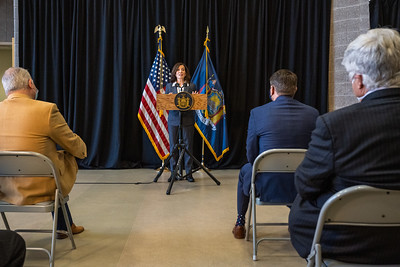New York Executive Budget: Cuts, Insurance Changes + 2026 Updates

New York Gov. Kathy Hochul unveiled her 2022-2023 Executive Budget in late 2021, which included a more than $10 billion, multi-year investment in the state’s healthcare system. It also contained two proposals that would affect the medical liability community.
Executive Budget Proposal: Healthcare Initiatives and Workforce Expansion
The governor’s budget proposal would fund healthcare initiatives to modernize the state’s emergency medical services, establish telehealth reimbursement parity, strengthen home care, improve retention of the existing medical workforce, expand access to training and education, and recruit care workers to underserved areas. Gov. Hochul believes these investments could expand New York’s healthcare workforce by 20% in the next five years.
Impact on Medical Malpractice Insurance Industry
Of specific interest to the medical malpractice insurance industry, the budget recommendation calls for legislation changing the pre- and post-judgment interest rate for liability awards from a fixed 9% statutory rate to a variable market-based one. With the notoriously lengthy process of adjudicating a medical liability claim, this change could equate to considerable savings in claims costs.
“The governor’s proposal to significantly reduce interest rates on court judgments would help to bring down New York’s exorbitant medical liability insurance costs,” said Joseph R. Sellers, MD, FAAP, FACP, Medical Society of the State of New York president.
“However, given the enormous challenges we have faced over the last two years, physicians are very concerned with another proposal that would thrust potentially significant new costs on countless physicians in the state who are enrolled in a long-standing program to provide supplemental insurance coverage to help offset New York’s notoriously high medical liability costs.”
Changes to Excess Medical Malpractice Insurance Program
Sellers is referring to the budget proposal’s call to modify the funding structure of the state’s Excess Medical Malpractice Insurance Program. Under Section 18 of the New York Medical Malpractice Reform Act, physicians who maintain primary insurance coverage limits of $1.3 million per claim and $3.9 million in annual aggregate with a New York State-admitted medical liability insurance company are eligible — at no cost — for an additional $1 million per claim and $3 million in annual aggregate coverage from the state’s excess medical liability insurance program.
Access to the free program has been a competitive advantage that medical professional liability insurance companies operating in the state’s standard admitted market have had over risk retention groups and other alternative risk transfer products.
Funding and Restructuring of Excess Insurance Program
Gov. Hochul’s budget provides $102 million for the Excess Medical Malpractice Insurance Program, the same amount as last year. However, it restructures the program so eligible physicians would be required to purchase excess coverage directly from a provider of excess liability insurance coverage. From funds available in the excess liability pool, the Department of Financial Services would reimburse 50% of the premium after the policy period, and the remaining 50% would be paid one year after.
“GNYHA strongly opposes this proposal,” said the Greater New York Hospital Association in a message to members. “There is a significant risk that physicians will forgo buying excess insurance if they have to pay out of pocket for it and wait two years for full reimbursement.”
“This would also add costs to hospitals, either for paying the contribution on behalf of employed physicians, if the hospital can afford it, or in the form of expanded exposure, if physician codefendants forgo excess coverage, because they cannot afford it. This proposal would more significantly impact safety net hospitals and lower-income physicians.”
Key Provisions in the 2025-26 New York Executive Budget
Governor Hochul’s 2025-26 Executive Budget plans major healthcare investments, allocating $134.3 billion to the New York State Department of Health. This includes $111.2 billion for Medicaid and $1.51 billion for capital projects, a $9.2 billion increase from last year. The budget aims to enhance healthcare delivery through several initiatives:
- Increased Review of Healthcare Deals: The budget suggests changes to New York’s material transaction disclosure law, requiring healthcare entities to give more detailed information to the NYSDOH.
- This includes extending the notice period to sixty days before closing and permitting NYSDOH to conduct a cost and market impact review. These changes may increase transaction costs and extend timelines, but do not require NYSDOH approval to proceed.
- Elimination of “Prescriber Prevails” in Medicaid: The budget proposes removing the “prescriber prevails” rule from Medicaid by January 1, 2026. This change would let Medicaid decide on the necessity of non-preferred drugs, potentially saving $61.9 million but possibly limiting patient access to needed medications.
Strengthening New York’s Health Care System
Facing the challenges of the COVID-19 pandemic, Governor Hochul is committed to making smart investments to protect the health and well-being of New Yorkers. This year’s plans include:
- $35.4 billion for New York’s Medicaid Program: This includes $1.6 billion in federal funds from an assessment on Managed Care Organizations (MCOs).
- $1.3 billion for the Safety Net Transformation Fund: This supports hospitals that serve at-risk New Yorkers, ensuring they can continue providing essential services.
- $800 million for SUNY Hospitals: These funds are for facility improvements, enhancing the quality of care.
- $694 million for Workforce Development: This investment supports programs for health care, behavioral health, and social care workers, addressing key workforce needs.
- $50 million for Abortion Access: This funding supports abortion access and protects providers from violence or harassment, ensuring safe and fair care for everyone.
Secure Your Practice with Tailored Malpractice Insurance
As New York’s healthcare landscape changes, protect your practice with the right malpractice insurance. Confidently manage these changes and secure your career with coverage that fits your needs. Don’t leave your future to chance, get a quote today with Cunningham Group.
*This article has been updated with new information
Cited Sources:
Health-Related Executive Budget Summary
2026 Executive Budget Highlights



